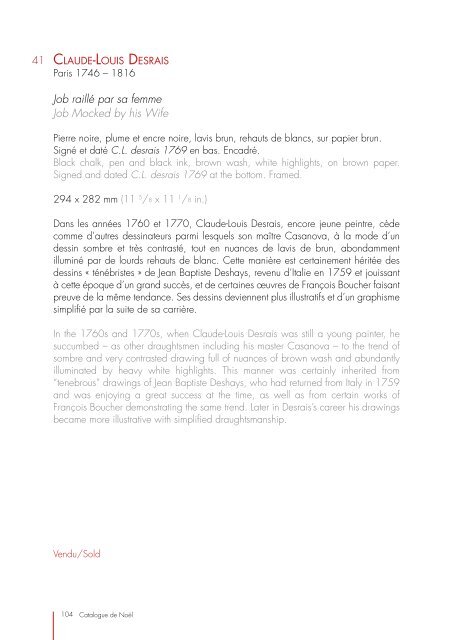You also want an ePaper? Increase the reach of your titles
YUMPU automatically turns print PDFs into web optimized ePapers that Google loves.
41<br />
Clau<strong>de</strong>-Louis Desrais<br />
Paris 1746 – 1816<br />
Job raillé par sa femme<br />
Job Mocked by his Wife<br />
Pierre noire, plume et encre noire, lavis brun, rehauts <strong>de</strong> blancs, sur papier brun.<br />
Signé et daté C.L. <strong>de</strong>srais 1769 en bas. Encadré.<br />
Black chalk, pen and black ink, brown wash, white highlights, on brown paper.<br />
Signed and dated C.L. <strong>de</strong>srais 1769 at the bottom. Framed.<br />
294 x 282 mm (11 5 /8 x 11 1 /8 in.)<br />
Dans les années 1760 et 1770, Clau<strong>de</strong>-Louis Desrais, encore jeune peintre, cè<strong>de</strong><br />
comme d’autres <strong>de</strong>ssinateurs parmi lesquels son maître Casanova, à la mo<strong>de</strong> d’un<br />
<strong>de</strong>ssin sombre et très contrasté, tout en nuances <strong>de</strong> lavis <strong>de</strong> brun, abondamment<br />
illuminé par <strong>de</strong> lourds rehauts <strong>de</strong> blanc. Cette manière est certainement héritée <strong>de</strong>s<br />
<strong>de</strong>ssins « ténébristes » <strong>de</strong> Jean Baptiste Deshays, revenu d’Italie en 1759 et jouissant<br />
à cette époque d’un grand succès, et <strong>de</strong> certaines œuvres <strong>de</strong> François Boucher faisant<br />
preuve <strong>de</strong> la même tendance. Ses <strong>de</strong>ssins <strong>de</strong>viennent plus illustratifs et d’un graphisme<br />
simplifié par la suite <strong>de</strong> sa carrière.<br />
In the 1760s and 1770s, when Clau<strong>de</strong>-Louis Desrais was still a young painter, he<br />
succumbed – as other draughtsmen including his master Casanova – to the trend of<br />
sombre and very contrasted drawing full of nuances of brown wash and abundantly<br />
illuminated by heavy white highlights. This manner was certainly inherited from<br />
“tenebrous” drawings of Jean Baptiste Deshays, who had returned from Italy in 1759<br />
and was enjoying a great success at the time, as well as from certain works of<br />
François Boucher <strong>de</strong>monstrating the same trend. Later in Desrais’s career his drawings<br />
became more illustrative with simplified draughtsmanship.<br />
Vendu/Sold<br />
104<br />
<strong>Catalogue</strong> <strong>de</strong> Noël
















